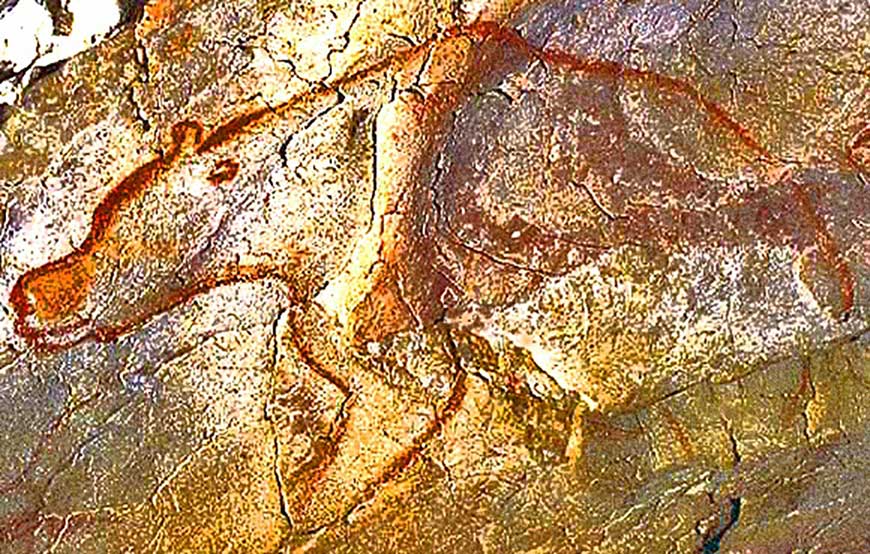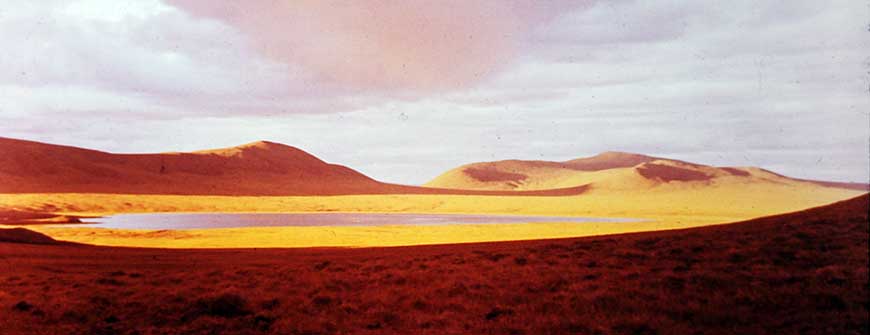 |
|
The Great Bear and I
Our party flew from Fairbanks to Bettles, Alaska a little after 6:00 p.m. There were five of us, the principal investigator (Dr. Karl Schlesier), a geologist (Dr. Egon Wiegel), and three graduate students (Hal Ottaway, Jon Wagner, and I). We'd brought almost a ton of camping gear, food, clothing, and archaeological supplies. We might have cut down the weight of our load considerably, but we hadn't been able to arrange for regular supply flights for the first month of our stay. Karl and I boarded the first flight -- a De Havillind Beaver float plane. It was so heavily loaded that Peter Mary, our bush pilot, had a tough time getting up enough speed to draw the floats out of the Koyukuk River and pull us into the air. We didn't climb fast even then. May Lake lies 125 miles north northwest of Bettles, but the overloaded De Havillind had to follow passes through the Brooks Range, North America's most northerly mountain range. We had so much cargo piled in and around me that I couldn't do the sight-seeing opportunity justice, but what I saw was spectacular. May Lake got its name because it usually became ice free in that month. Not all the lakes on the north slope did the same. We arrived about 11:00 p.m. No ice on the lake, but shallow patches of snow framed the lake's basin in the dusky twilight. June 17 began with the sun dipped below the horizon and the May Lake bowl further shadowed by the rounded humps of the Canoe Hills immediately to the north. Splashing to a stop took a lot less distance than getting ourselves in the air. May Lake, roughly 2000 feet in length, grabbed our floats and slowed us somewhere near the middle. The De Havillind turned, revved its prop, and pulled us to the south shore. Peter and Karl donned hip boots and began unloading our cargo. I filmed a brief sequence of their efforts, then assisted in getting our packs, boxes, and packages further ashore. As soon as we finished unloading, Peter fired up the Beaver and went to collect the three remaining crew members. Karl and I hiked up to the notch between a series of low ridges and some sharp, narrow peaks above Sedna Creek. You won't find Sedna Creek on many maps of the area. The geological maps didn't show it at all, at least not until after it joins the overflow meandering west out of May Lake. The overflow and the creek from that point on was called Canoe Creek, except by us. Since Sedna was the Eskimo goddess of the animals, Karl had named the quiet little stream that meandered from near Fortress Creek and flowed along the base of the ridges he and I climbed not long after midnight on June 18. The course had been carved out by Fortress Creek thousands of years ago, until Fortress altered its flow by breaking through a shale saddle between Fortress Mountain and the arc of unnamed ridges south of May Lake. Karl and another graduate student had surveyed the area three summers before. They had camped near May Lake and Canoe Creek in a sheltered spot, unfortunately ideal for mosquitoes. Karl thought the notch in the ridge, roughly a mile south of May Lake, would make a far better camp. Yes, it would and did catch the wind that funneled up off the lake and between the higher parts of the ridge on both sides. When the wind howled, as it did a few times that summer, we had to strike our tents and pile heavy supplies and equipment on them to keep them from being torn apart or blown away. But more often, it simply caught any breezes and blew the mosquitoes elsewhere, at least making it slightly more difficult for the little vampires to suck us dry. The float plane returned about 2:00 a.m. We unloaded, bade Peter Mary farewell, and watched our last contact with the outside world fly away. Karl had arranged for a weekly flyover to check on us, but the personnel at the Bettles station resigned and failed to explain our arrangement to their replacements. It would be two weeks before a plane flew over low enough to see that we were alive, and to drop our mail as it made a low pass over our camp. Then, another two weeks before a plane touched down on the lake with fresh food. We were beginning to wonder if that supply flight would come at all. Those concerns were yet to be encountered during the early hours after our arrival. We began moving our food and supplies up-slope across the swampy tundra -- all mud and sedges, and mosquitoes. The wind blew from the north where a dark cloud bank had formed. The drifts of snow that surrounded us on every side were a clear indication that seriously cold weather might yet be expected. Judging from those clouds, possibly very soon. We talked it over and decided it would be a good idea to take our Arctic tent and a Coleman stove up to the notch and set them up, just in case. Jon and I loaded up and started the climb. We were within about 250 yards of our proposed camp site when Jon heard sounds from where we'd left the others. They were waving and shouting, but we couldn't make out what they were saying. "Hurry up," we thought might be a possibility. So we hefted our tent and stove and continued on. The shouting behind us increased in volume. We paused again, listened harder. We thought we made out one word. "Bear!" If there was a bear near us, we had no idea where he was or what direction he was going. We assumed he was ahead of us. I wanted to keep going because I wanted to get a look at him. We'd seen a few lonely caribou coming off one of the ridges earlier, but they'd been about a mile away. Jon and I were in our early twenties, still immortal, or so we thought. We wanted to see some of Alaska's famed wildlife a little closer. We had no idea how fully our wish was about to be granted. Jon and I talked it over and, because the rest of our team seemed excited and upset, decided to leave the tent and stove where they were and start back down slope. Jon unslung his rifle. We had come to the Arctic well armed. We were more than 40 miles, as the raven flew, from the nearest outposts of civilization -- an Eskimo village and a geological field station that might or might not be occupied. If we encountered rabid wolves, an angry wolverine, or a hungry grizzly, we had to be responsible for our own safety. Jon had a .30 '06 rifle, a weapon with considerable stopping power. The only problem was he'd gotten it just before we left for Alaska. He'd never fired it. It might not be accurately sited in. Worse, for all he knew, it might not even shoot. I'd brought a 12 gauge semi-automatic shotgun. Since everyone else was bringing rifles, I though my choice was brilliant. I brought some bird loads so I could supplement our larder, if necessary, with ducks, geese, or ptarmigan. And, in case of bear, I'd brought rifled slugs. Massive, half-inch lead slugs grooved to spin coming out of a smooth bore barrel. They'd be reasonably accurate and deliver massive stopping power at ranges up to a few hundred yards. I didn't have a sling for the shotgun, though, so it was back with everyone else and all our supplies. I did have a pistol. My grandfather's .38 revolver was loaded with 200 grain wad cutters -- great for making nice clean holes in targets, but not really designed for bear hunting. The soft lead of the wad cutter would spread on impact and could do tremendous damage to soft body parts. Not that a bear was likely to present me with soft body parts as targets. We'd covered about 75 yards toward where our companions waited, nearly a mile away, back at the lake. As we descended, we'd been watching behind us, expecting the bear to come from there. Instead, I turned toward the edge of the ridge 80 yards ahead and there he was, lumbering easily over the tundra in our direction. I told Jon and raised my pistol, steadying it with a two handed grip. Jon raised his rifle, I think. I didn't turn to check. The bear spotted us and slackened his pace, but continued toward us until he stood about 50 yards away. The characters in my book, The Spirit and the Skull, are concerned with a great bear, even bigger than the one Jon and I faced. The short-faced bear, Ursus arctodus simus, is considered to have been one of the largest terrestrial mammalian carnivores, ever. They could weigh more than a ton and stand up to 6 feet at the shoulder -- as much as 12 feet tall on its hind legs. Our great bear was a grizzly, Ursus arctos horribilis. Grizzlies weigh a mere 400 to 1500 pounds with a shoulder height between 3 and 5 feet. A large male may stand nearly ten feet tall when upright on its hind legs. The horribilis classification was earned due to its aggressive character. I didn't have time to consider how big this grizzly was. He looked more than big enough to me. I found myself focused on the bear's massive jaws, broad and muscular shoulders, and its eyes, then clearly focused on the two strangers in its path. Jon and I stood very still. We'd been instructed not to show fear if we should ever face a bear. The last thing to do was to run -- almost certainly, literally, the last terminal thing we might do. I remember realizing we were very unlikely to stop him if he charged, and what our fate would probably be in that event. That may have been the exact moment when my perceived immortality ended. He sniffed at us, trying to catch our scent. It's possible he'd never encountered humans before. We stood, he staring at us, we at him, for what seemed like several minutes. It may not have even been one minute. He snorted and began to amble slowly along the ridge toward our tent and stove. We began walking slowly away from him. The moment we did, he turned back toward us. After another brief face off, he turned and walked away. Later, in consultation with Karl, Egon, and Hal, we decided our bear had been midsized, about 700 pounds. Big enough for me. We'd been afraid as we faced him, but we hadn't panicked. After it was over, the adrenaline faded and I felt completely worn out -- exhausted from the potential attack and defense we didn't experience. We'd been on the North Slope for only a few hours, faced our great bear, and survived. So had he. An ideal result in my opinion. During the summer, we encountered other grizzlies. But never again face-to-face. I cherish the memory of seeing that magnificent omnivore at such close quarters in the wild. But I had no desire to do it a second time. The next horribilis might have charged. Then you wouldn't have the opportunity to read The Spirit and the Skull and I wouldn't be sharing stories of great bears I've known and imagined.
The May Lake bowl. |
 |

